Diversification of Villa-Type Neighborhoods and Its Impact on Housing Shortages in a Growing Saudi Arabian City: A Case Study of Jeddah
Abstract
1. Introduction
1.1. Research Background
1.2. Research Area
1.3. Research Objectives
- Identify solutions to issues relating to Jeddah’s population growth through a review and analysis of (a) the total housing shortage and projected demand, (b) factors responsible for the housing shortage problem, (c) the local government’s housing policy and strategy, and (d) the actual status of population density within each district in Jeddah (Section 2);
- Analyze articles of the PMPRLS and assess the extent to which they foster diversity in relation to land lot areas, total street length, numbers of villas, population density, and numbers of children’s playgrounds in villa-type neighborhoods (Section 3);
- Clarify the extent to which the articles in the PMPRLS are applicable to existing neighborhoods and the extent to which the patterns of contemporary neighborhoods can be seen as being part of the housing shortage problem (Section 4); and
- Determine the compositional characteristics of the 103 sites by dividing them into groups according to several indicators, which are discussed in the following section on research methods. A further aim was to propose methods of developing each group as an initiative toward resolving the housing shortage problem (Section 5).
1.4. Research Methods
1.4.1. Issues Relating to the Housing Shortage and Projected Demand
1.4.2. Planned Neighborhood Composition
- The characteristics of elements of a neighborhood, such as the ratio of land use, streets, open spaces, and public land and how they have been combined together [12].
- As Saudi Arabia is an Islamic country where mosques are used five times a day, the mosques in several residential blocks are centrally located within a service area distance of 200 m, as noted in the PMPRLS. Therefore, we conceptualized the elements of a neighborhood by situating them within an area having a radius of 200 m from a centrally positioned mosque.
- We performed two verifications in the following cases: (1) where the total areas of streets (as shown in the PMPRLS) accounted for 20% of the total neighborhood area, and (2) when the minimum street width was 10 m (as shown in the PMPRLS). Subsequently, we determined how these conditions can affect the ratios of other elements, such as the total area of public facilities, the total street length, the number of villas, and population density.
1.4.3. Actual Conditions in Existing Villa-Type Planned Neighborhoods
- The extent to which the PMPRLS is actually applied in villa-type neighborhoods in Jeddah;
- The extent to which existing villa-type neighborhoods can be part of the solution to the existing housing shortage if the same pattern of their development is maintained.
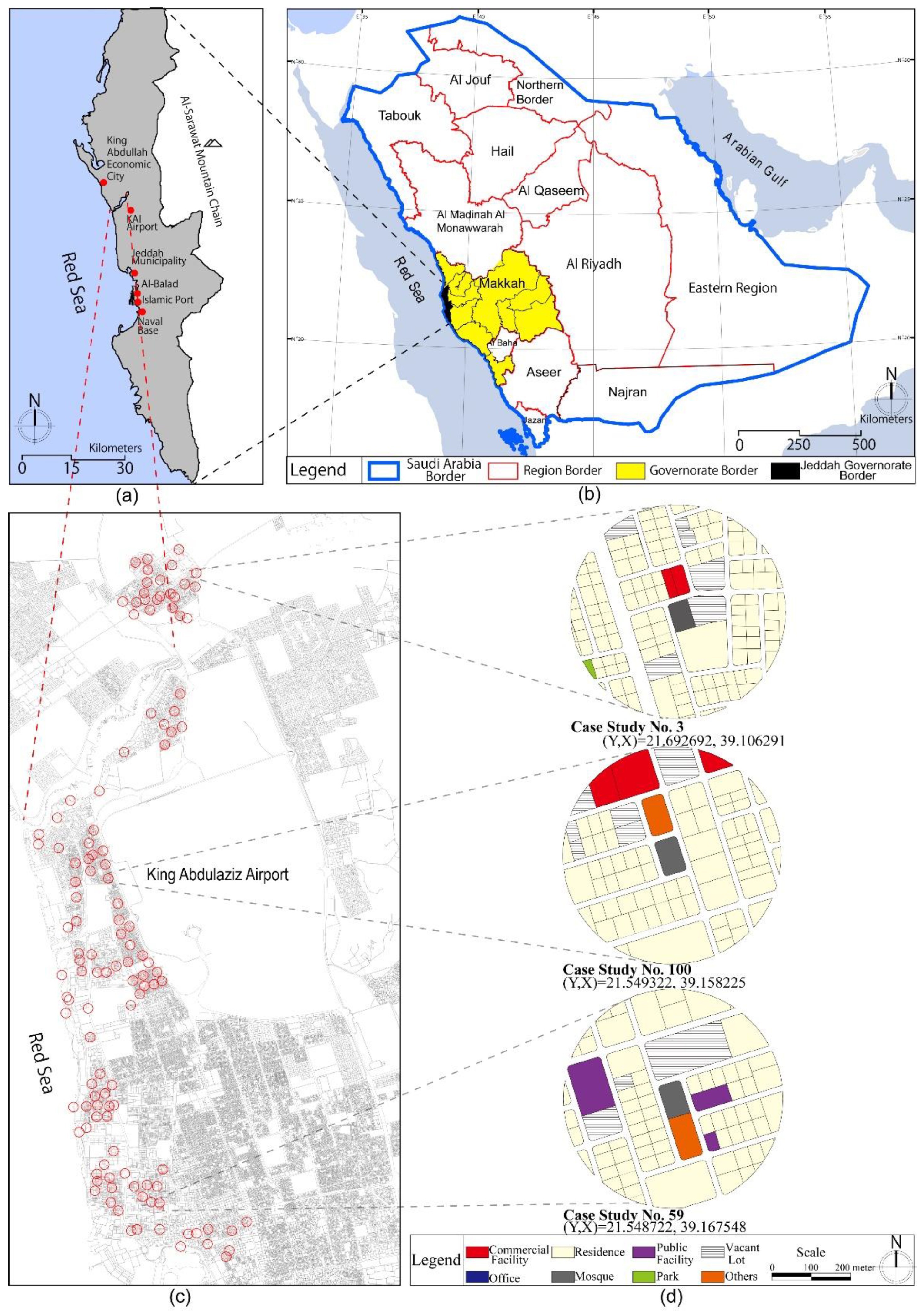
1.4.4. Typology of Existing Villa-Type Neighborhoods and Proposals
1.5. Previous Studies
2. Housing Policies and Issues in Jeddah
2.1. The Housing Shortage and Projected Demand
2.2. The Housing Shortage Problem and Related Factors
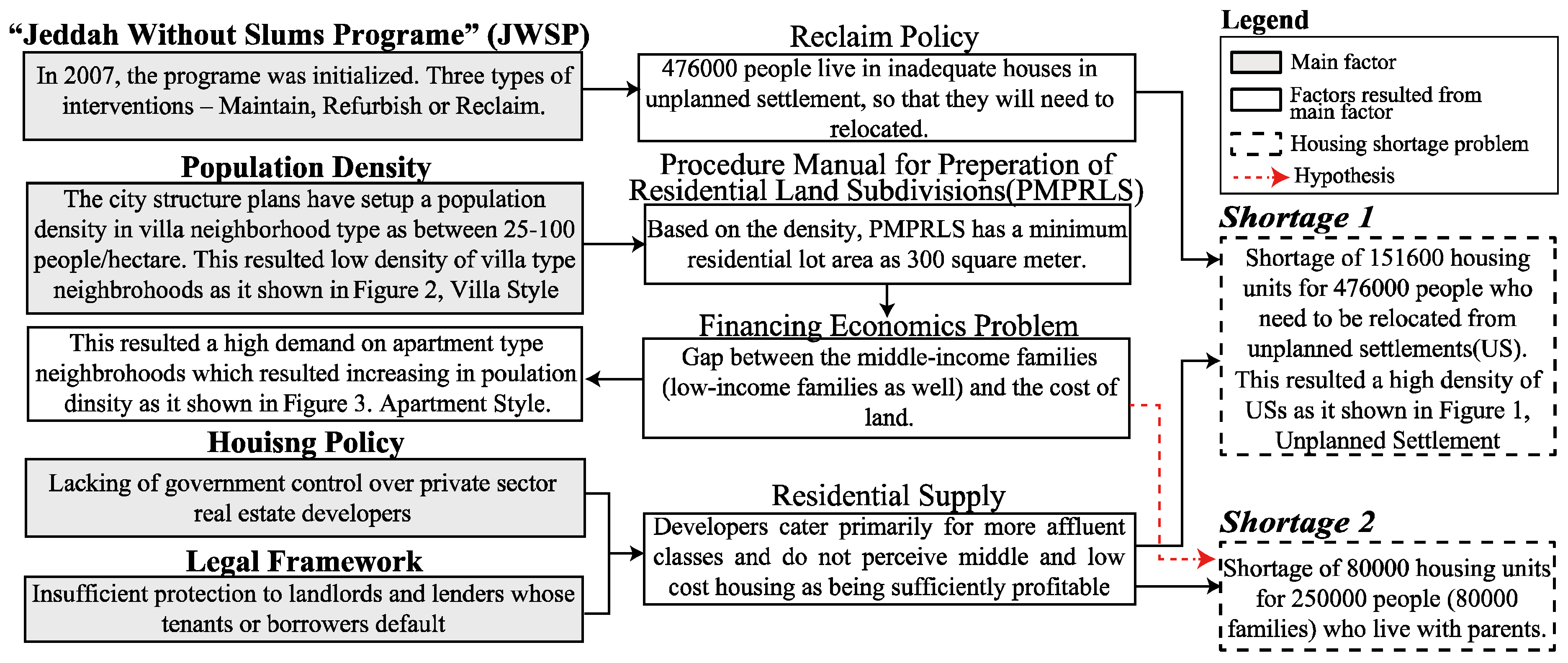
- Jeddah without Slums Program (JWSP)
- 2.
- Population Density
- 3.
- Housing Policy
- 4.
- Legal Framework
- 5.
- Financing Economics Problem
2.3. Population Density in Residential Districts
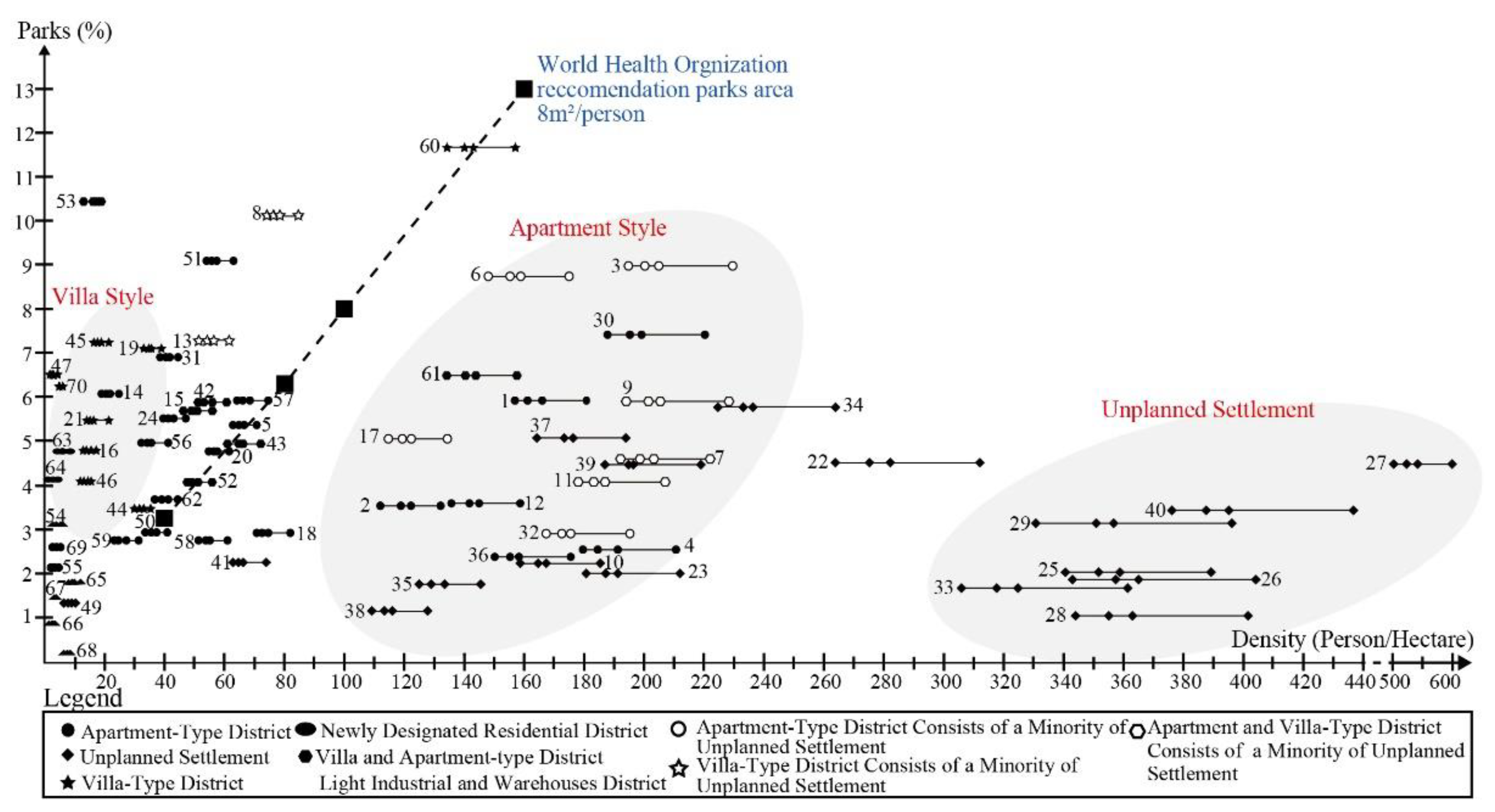
3. New Villa-Type Neighborhood Development
3.1. Procedure Manual for Preparing of Residential Land Subdivision (PMPRLS)
3.2. Application of the Procedure Manual in Relation to an Area with a Radius of 200 m
| AoVLA (ha) | STA (ha) | PFTA (ha) | TSL (m) | NoV (Unit) | PD (Person/ha) | NoCP (Unit) |
|---|---|---|---|---|---|---|
| 0.03 (300 m2) | 1.63 (13%) | 1.63 (13%) | 1633 | 310 | 123 | 15 |
| 0.04 (400 m2) | 1.51 (12% | 1507 | 236 | 94 | 12 | |
| 0.06 (600 m2) | 1.38 (11% | 1382 | 159 | 63 | 8 | |
| 0.08 (800 m2) | 1.26 (10%) | 1256 | 121 | 48 | 6 | |
| 0.1(1000 m2) | 1.13 (9%) | 1193 | 97 | 39 | 5 | |
| 0.2(2000 m2) | 1.00 (8%) | 1005 | 50 | 20 | 2 | |
| 0.25(2500 m2) | 1.00 (8%) | 942 | 40 | 16 | 2 |
4. Existing Conditions in Villa-Type Neighborhoods According to the PMPRLS
4.1. Index Analysis
4.2. The PMPRLS and Actual Condition
4.3. Contemporary Villa-Type Neighborhoods and the Housing Shortage
5. Elements of Neighborhoods and Their Correlations
5.1. Correlation Analysis
5.2. Multiple Regression Analysis
| Model | Unstandardized Coefficients | Standardized Coefficients | t | Sig. | Collinearity Statistics | |||
|---|---|---|---|---|---|---|---|---|
| B | Std. Error | Beta | Tolerance | VIF | ||||
| 1 | (Constant) | 53.368 | 9.359 | - | 5.703 | 0.000 | - | - |
| Distance between mosque and park | 0.011 | 0.004 | 0.243 | 2.689 | 0.008 | 0.867 | 1.154 | |
| Total length of roads | −0.015 | 0.004 | −0.288 | −3.346 | 0.001 | 0.951 | 1.052 | |
| Ratio of lots ranges between 1000 and 1400 m2 | 0.517 | 0.170 | 0.269 | 3.042 | 0.003 | 0.901 | 1.110 | |
5.3. Groupings and Suggestions
- Group A (26 sites)
- 2.
- Group B (38 sites)
- 3.
- Group C (22 sites)
- 4.
- Group D (5 sites)
- 5.
- Group E (7 sites)
- 6.
- Group F (4 sites)
6. Conclusions
Author Contributions
Funding
Data Availability Statement
Acknowledgments
Conflicts of Interest
References and Notes
- Hass-Klau, C.H.M. The Housing shortage in Germany’s Major Cities. Built Environ. 1982, 8, 60–70. [Google Scholar]
- Abhay, R.K.; Sharma, M. Housing Shortage in a mega city: A spatio-temporal analysis of NCT-Delhi, 2001–2011. GeoJournal 2022. [Google Scholar] [CrossRef]
- Kumar, A. Estimating Rural Housing shortage. Econ. Political Wkly. 2014, 49, 74–79. [Google Scholar]
- Gabbe, C.J. Local regulatory responses during a regional housing shortage: An analysis of rezoning in Silicon Valley. Land Use Policy 2019, 80, 79–87. [Google Scholar] [CrossRef]
- Tian, L. Breaking the land monopoly: Can collective land reform alleviate the housing shortage in China’s mega-cities? Cities 2020, 106, 102878. [Google Scholar] [CrossRef]
- Surf, M.A.; Susilawati, C.; Tringunarsayah, B. Analyzing the Literature for the Link between the Conservative Islamic Culture of Saudi Arabia and the Design of Sustainable Housing. In Proceedings of the 2nd International Conference Socio-Political and Technological Dimensions of Climate Change, Kuala Lumpur, Malaysia, 1 November 2012. [Google Scholar]
- Hegazy, I.; Helmi, M.; Qurnfulah, E.; Naji, A.; Ibrahim, H.S. Assessment of Urban growth of Jeddah: Towards a liveable urban management. Int. J. Low-Carbon Technol. 2021, 16, 1008–1017. [Google Scholar]
- Mulliner, E.; Algrnas, M. Preferences for housing attributes in Saudi Arabia: A comparison between consumers’ and property practitioners’ views. Cities 2018, 83, 152–164. [Google Scholar] [CrossRef]
- Jeddah Strategic Plan; Jeddah Municipality, May 2009.
- General Authority for Statistics. Housing Statistics Bulletin. 2019. Available online: https://www.stats.gov.sa/ar/911-0 (accessed on 8 February 2021).
- Jeddah Municipality. Jeddah Structure Plans. Available online: https://www.jeddah.gov.sa/index.php (accessed on 6 May 2015).
- Ministry of Municipal and Rural Affair and Housing. Procedure Manual for Preparation of Residential Land Subdivision. 2005. Available online: https://www.momra.gov.sa/ar/regulations (accessed on 1 October 2015).
- Jeddah Municipality. Jeddah Autocad Map. 2016.
- Ministry of Justice. Real Estate Indicators of Neighborhoods. 2016. Available online: https://www.moj.gov.sa/ar/opendata/bi/birealestateDistrct/Pages/Yearly.aspx (accessed on 7 May 2015).
- Abu-Ghazzeh, T.M. Built form and religion: Underlying structures of jeddah al-qademah. Tradit. Dwell. Settl. Rev. 1994, 5, 49–59. [Google Scholar]
- Salama, A.M. A lifestyle theories approach for affordable housing research in Saudi Arabia. Emir. J. Eng. 2006, 11, 67–76. [Google Scholar]
- Attia, M. Sustainability Features of Jeddah Traditional Housing. In Sustainable Housing; IntechOpen: London, UK, 2021. [Google Scholar] [CrossRef]
- Jambi, R.; Saci, K. House Pricing Determinants from Buyers Perspective in Jeddah, Saudi Arabia. PalArch’s J. Archaeol. Egypt/Egyptol. 2021, 18, 1001–1006. [Google Scholar]
- Maddah, R.; Deguchi, A. Evaluation and Redefinition of Open Spaces in Neighborhoods of Hot Arid Region: Case of Jeddah City, Kingdom of Saudi Arabia. J. Sustain. Urban. Regen. 2016, 1, 1–11. [Google Scholar]
- Maddah, R.; Song, J.; Deguchi, A. Motorization and Pedestrianization Issues based on Design Standards in Planned Neighborhoods in Jeddah City, Saudi Arabia. Urban Reg. Plan. Rev. 2016, 3, 187–202. [Google Scholar] [CrossRef][Green Version]
- Maddah, R. The measurement of walkability in villa-type neighborhoods: Using HPE’s walkability index: Case of Jeddah City, Saudi Arabia. In Proceedings of the International Conference Virtual City and Territory, Barcelona, Spain, 21 December 2019. [Google Scholar]
- Mousalli, M.S. Residential Location in Jeddah, Saudi Arabia: A Partial Symbolic Representation. J. King Abdulaziz Univ.-Eng. Sci. 1999, 11, 31–49. [Google Scholar]
- Al-Otaibi, A. The Aspiration for Housing in Jeddah—Saudi Arabia. Economics. 2004. Available online: https://www.semanticscholar.org/paper/The-Aspiration-for-Housing-in-Jeddah-Saudi-Arabia-Al-Otaibi/70128f7ea8dfdb4375bbbc4caab2d87ffb573ff1 (accessed on 7 September 2021).
- Murad, A. Creating a GIS application for retail centers in Jeddah city. J. Comput. Science 2011, 7, 902–908. [Google Scholar] [CrossRef][Green Version]
- Assaf, S.A.; Bubshaitr, A.A.; Al-Muwasheer, F. Factors affecting affordable housing cost in Saudi Arabia. Int. J. Hous. Mark. Anal. 2010, 3, 290–307. [Google Scholar] [CrossRef]
- Alqahtany, A. Affordable housing in Saudi Arabia’s vision 2030: New development and new challenges. Int. J. Hous. Mark. Anal. 2020, 14, 243–256. [Google Scholar] [CrossRef]
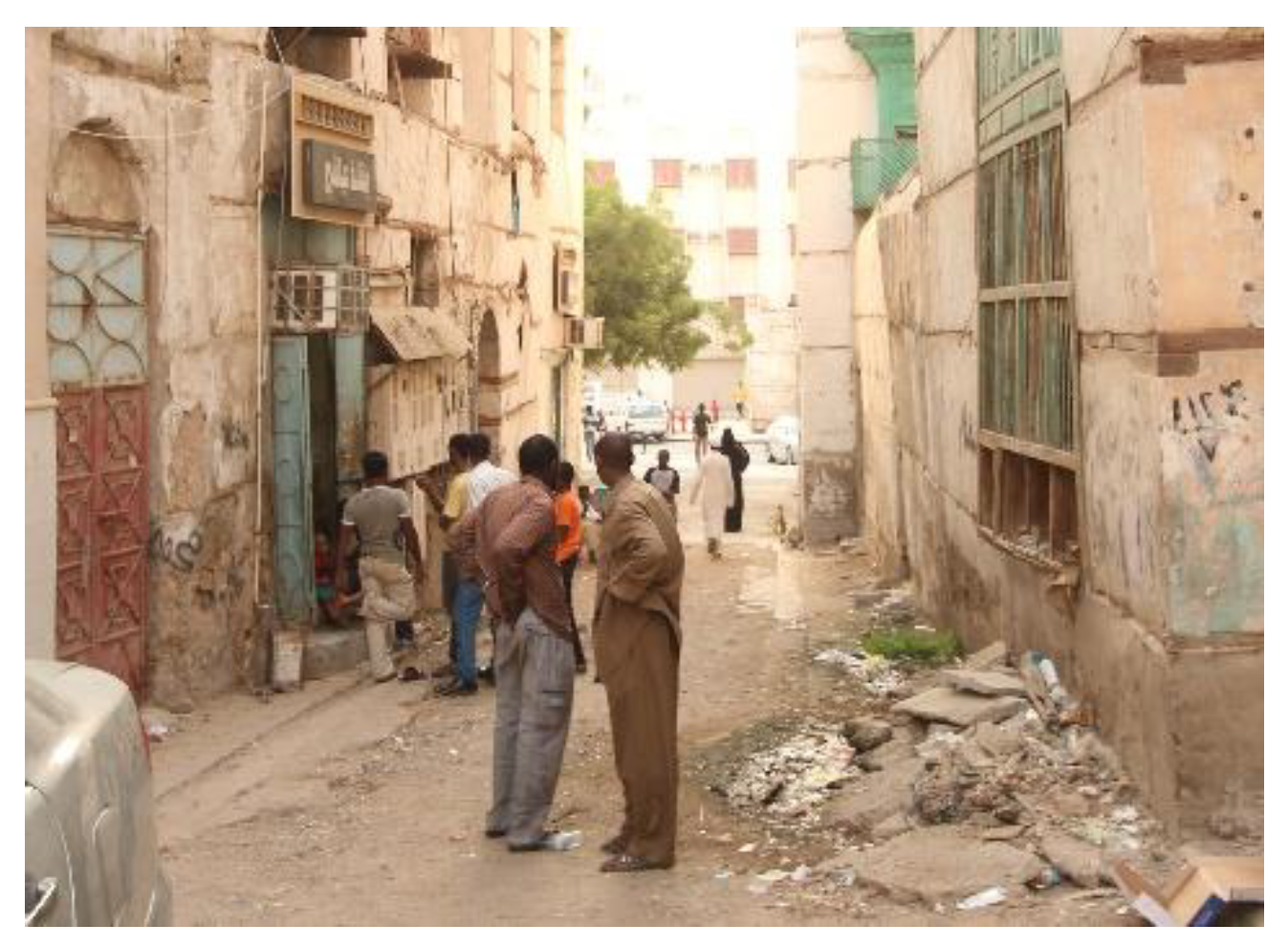
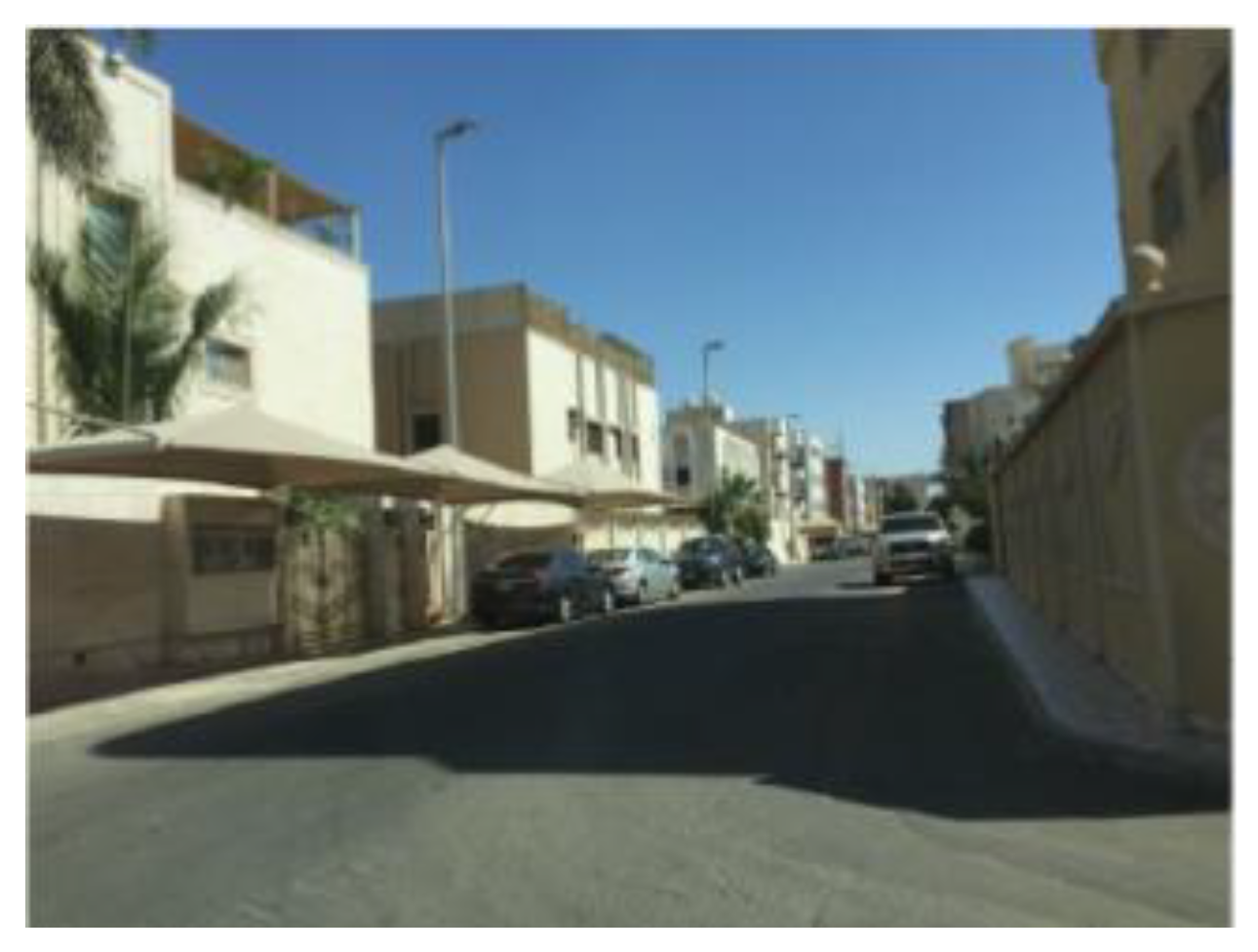
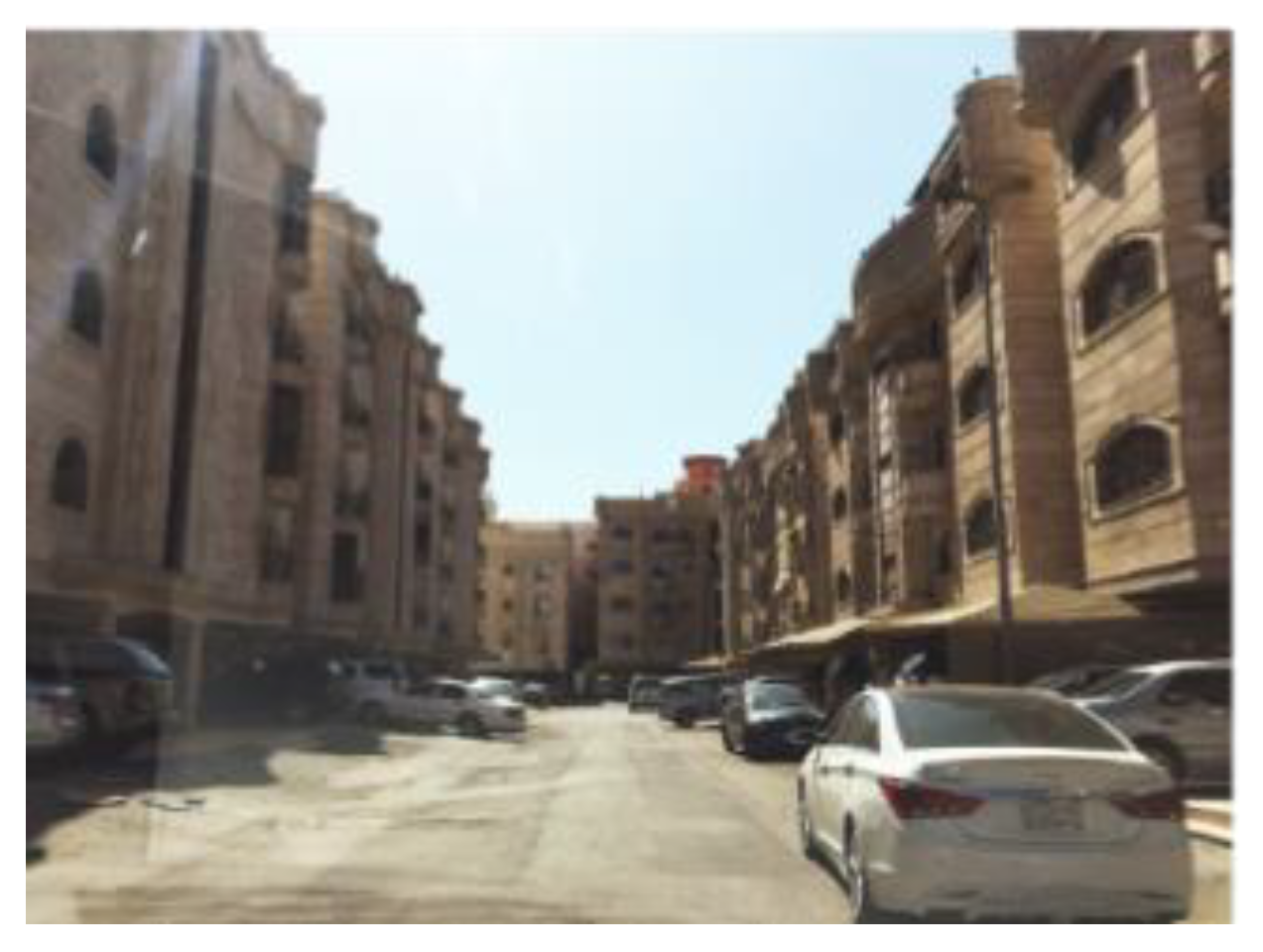
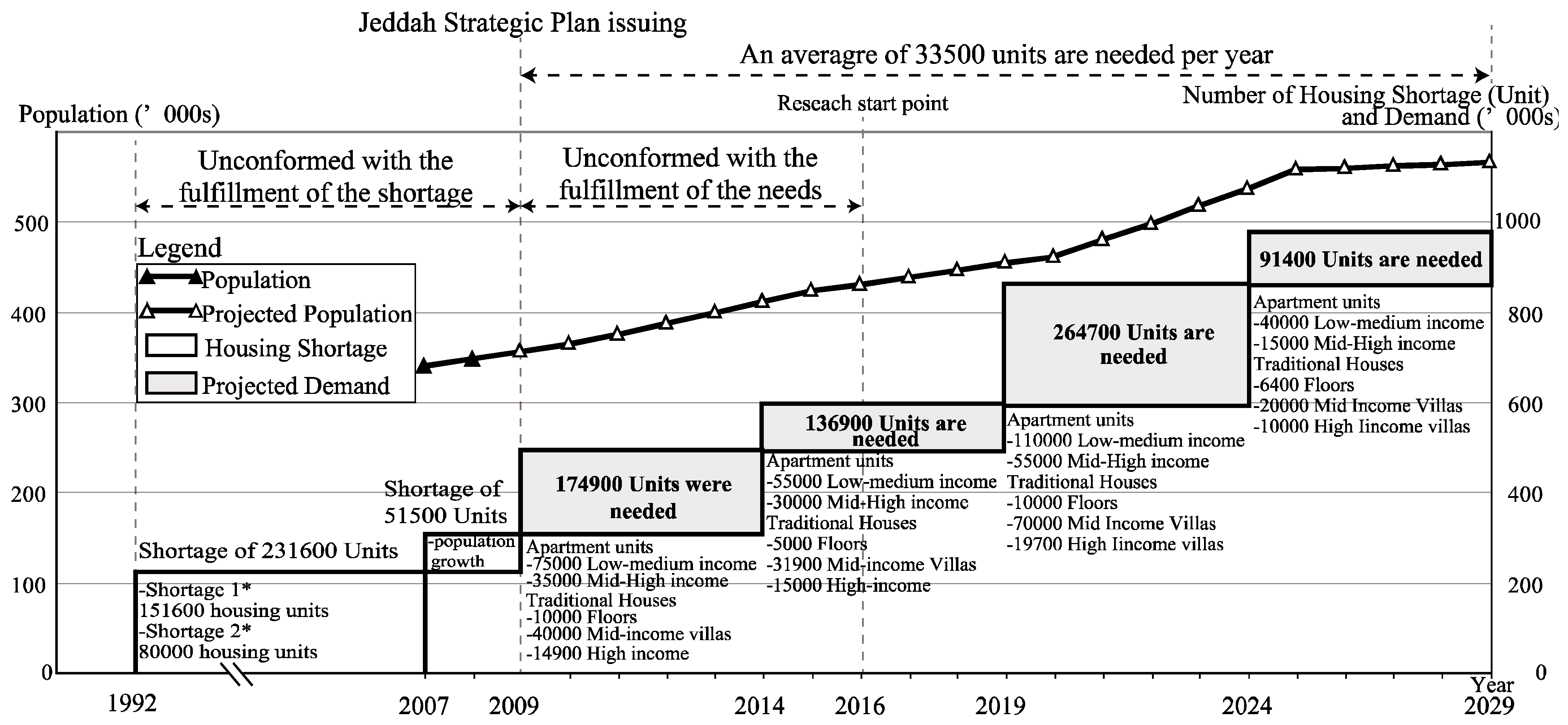
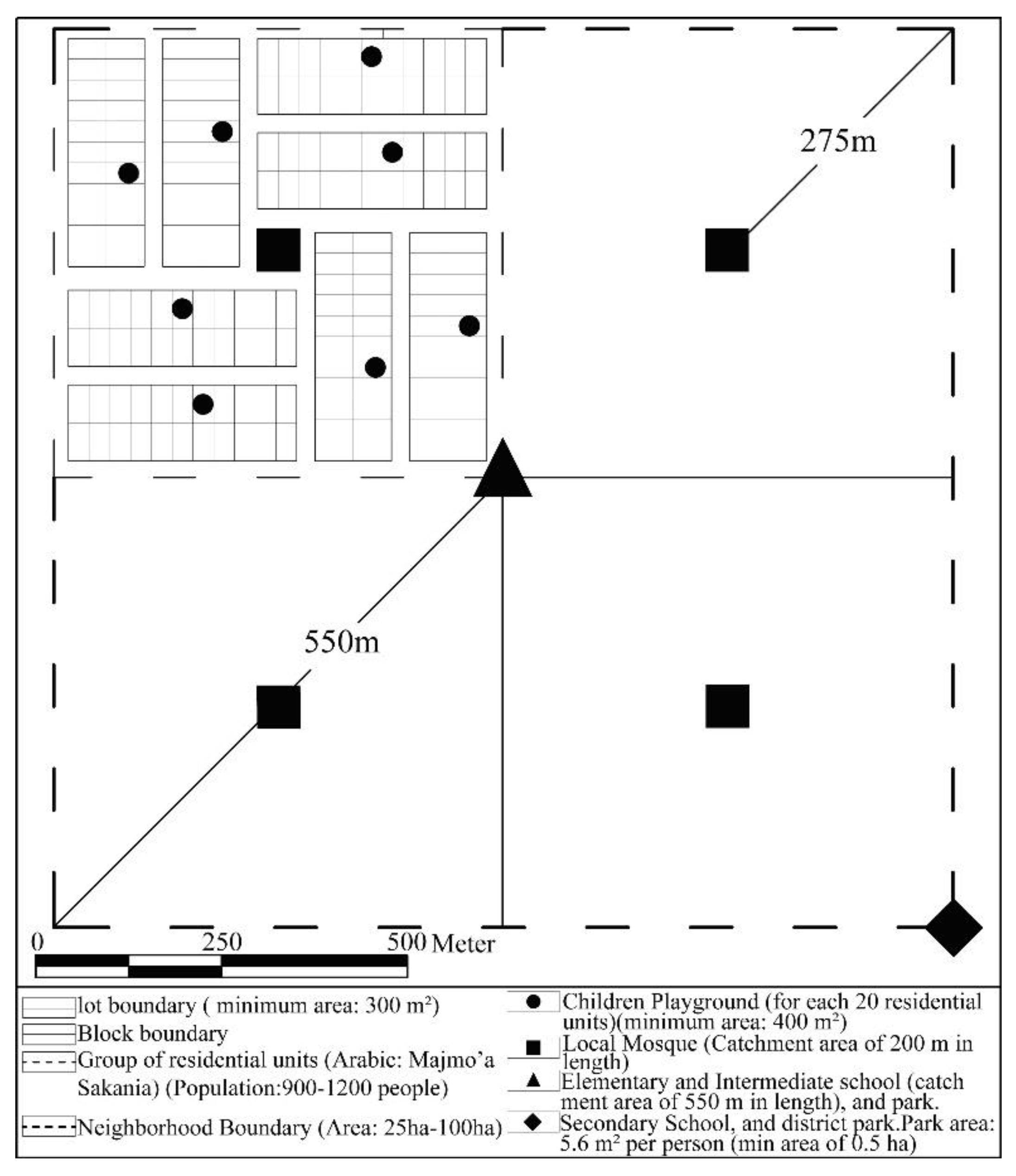


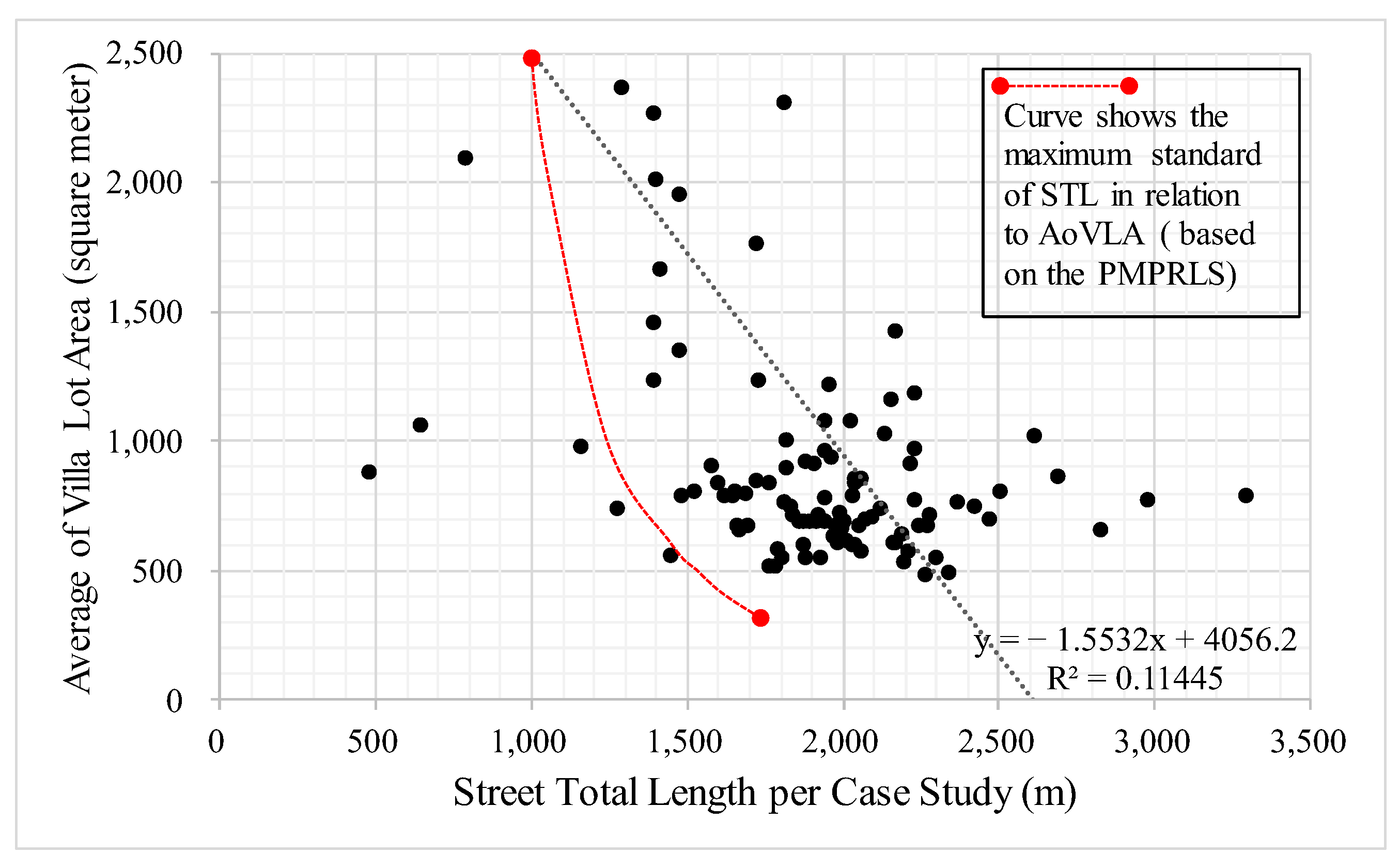
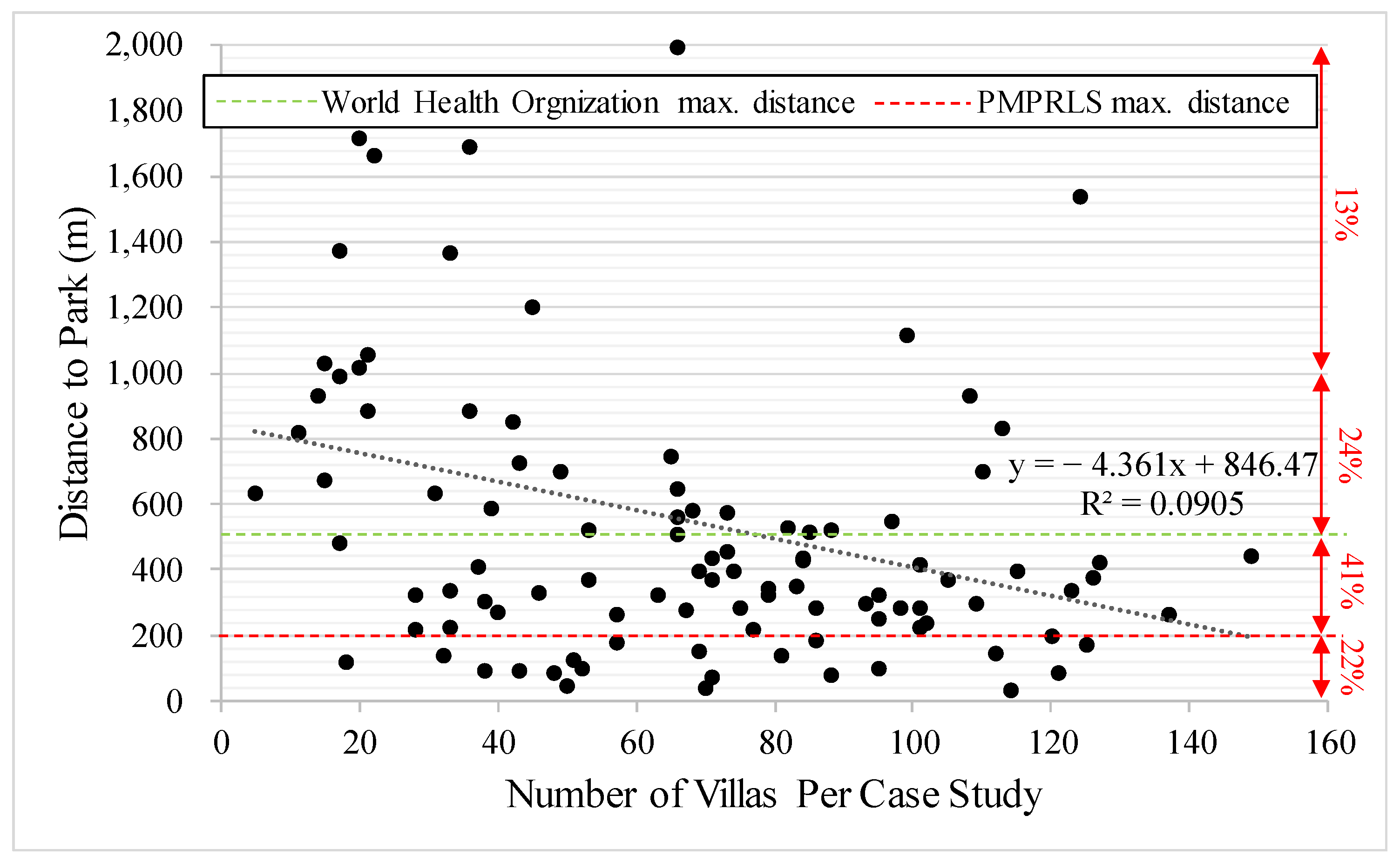
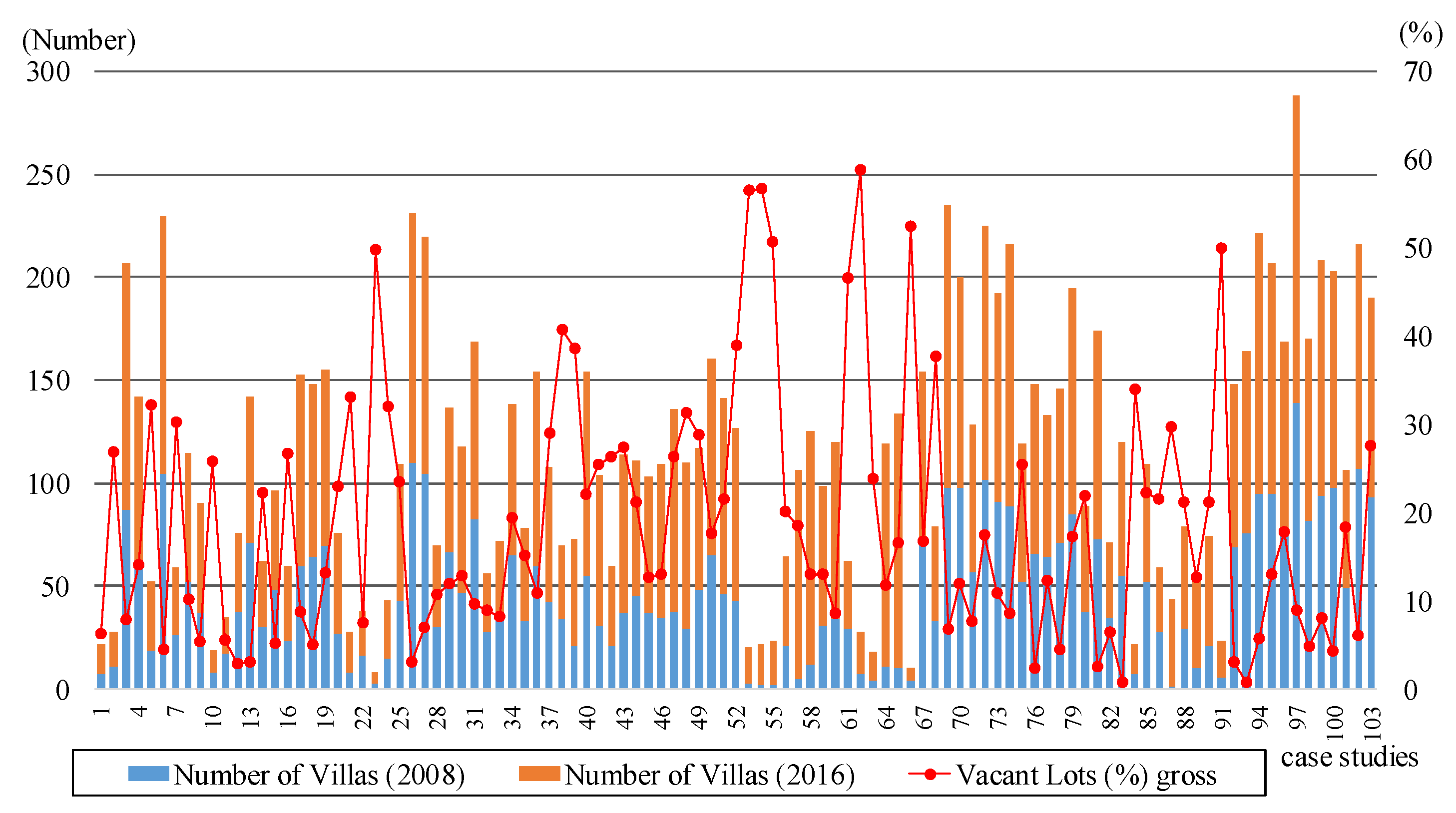
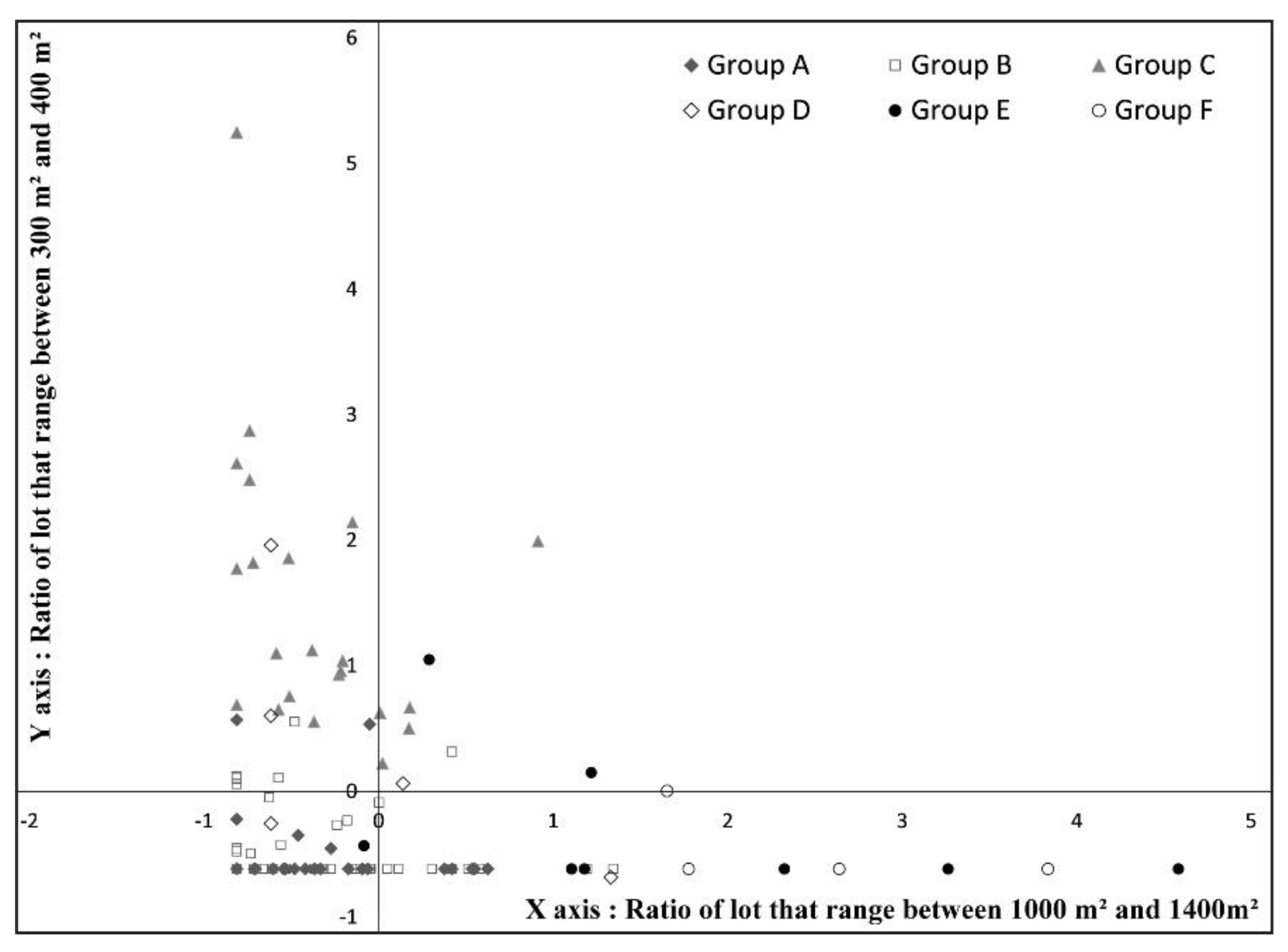

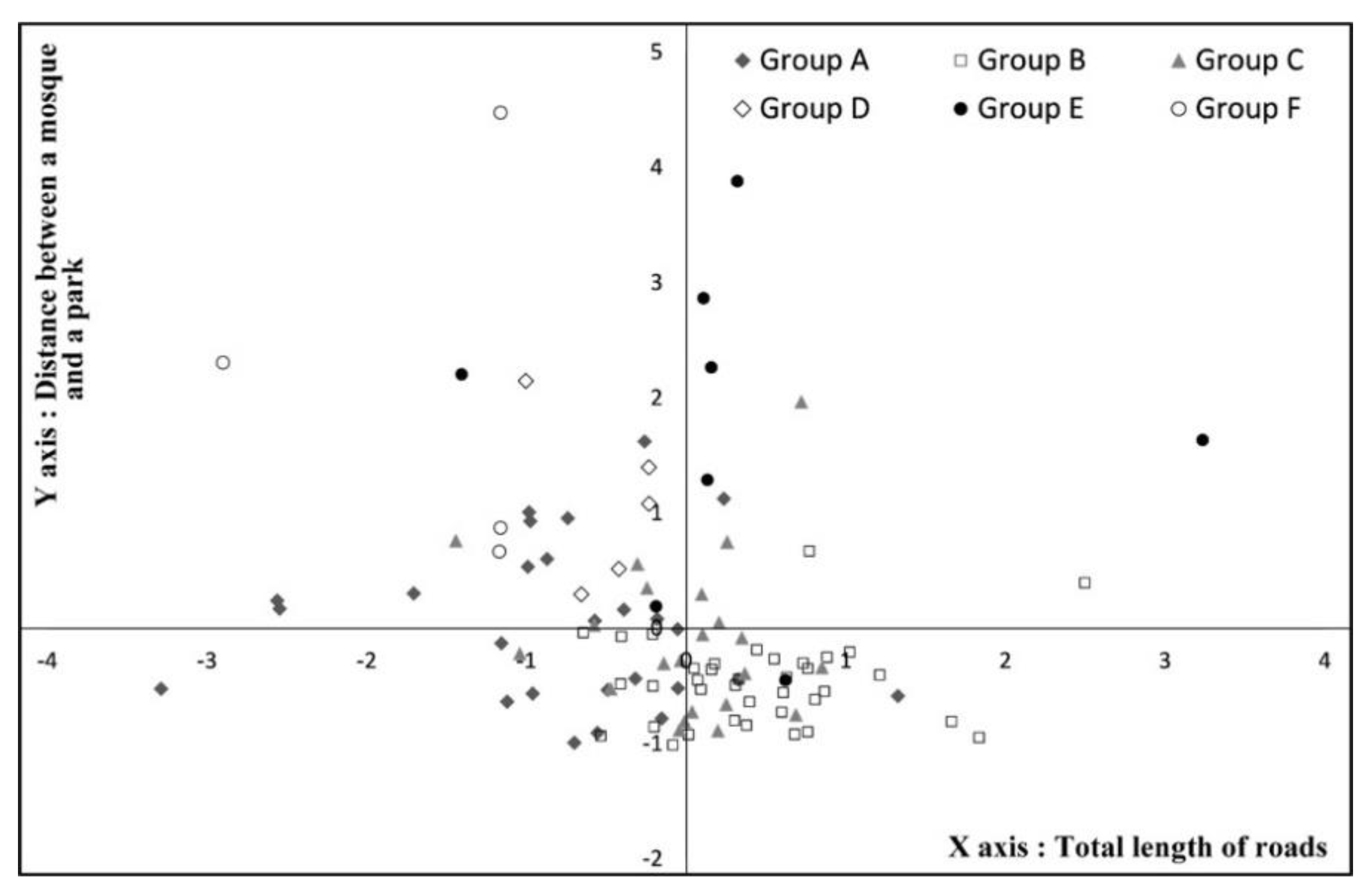
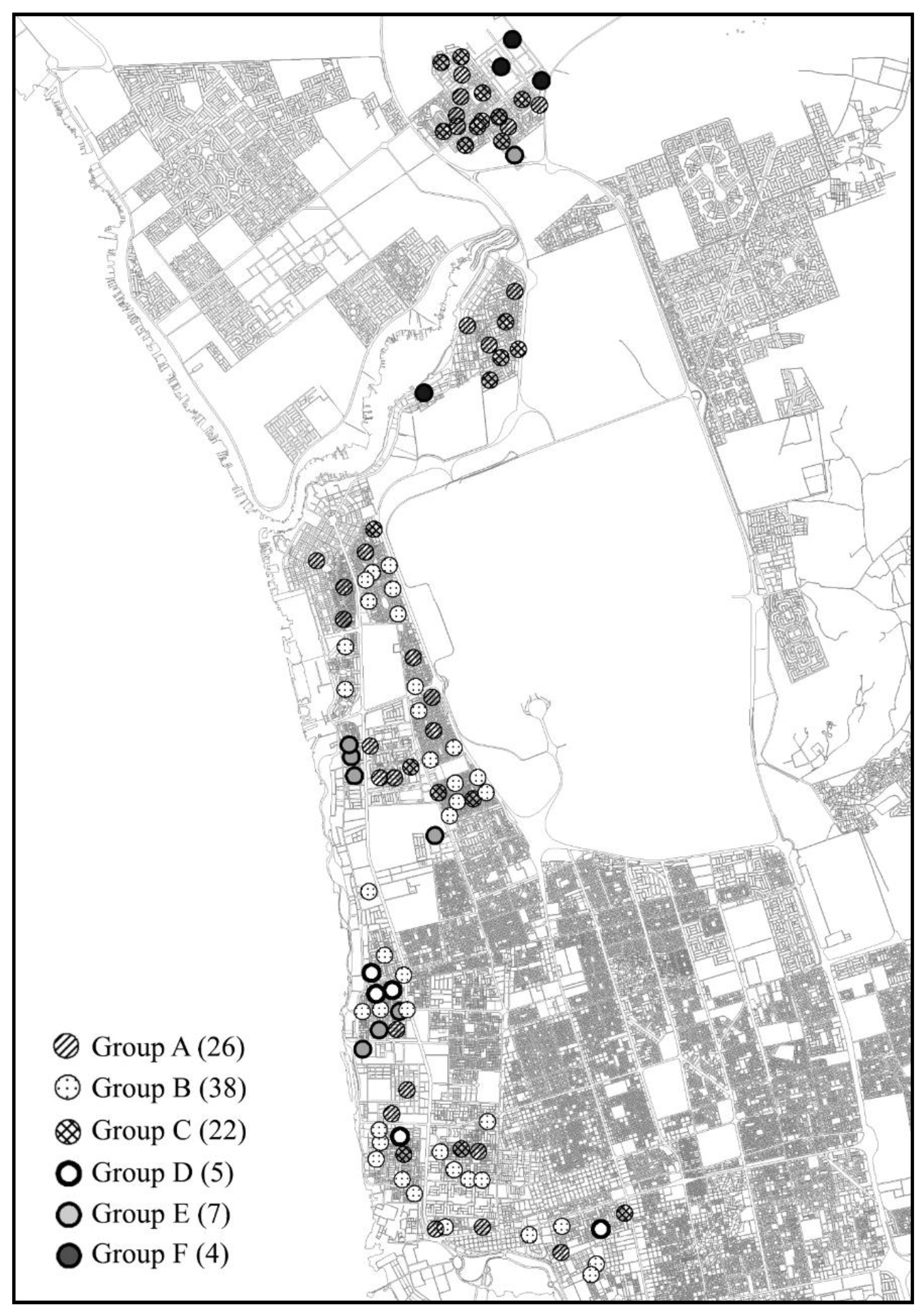
| Structural Plans District Type | 1st Structural Plan 1963 | 2nd Structural Plan 1973 | 3rd Structural Plan 1978 | 4th Structural Plan 1987 | 5th Structural Plan 2004 |
|---|---|---|---|---|---|
| Unit: People/Hectare | |||||
| Within an urbanized area | 100–150 | - | |||
| Outside an urbanized area | 50–100 | ||||
| Large villa | - | 15 | - | ||
| Villa | 50 | 75 | 25 | 40–70 | |
| Apartment | 15 | 175 | 150–200 | 90–200 | |
| Average Area of Villa Lot (in m2) | Maximum Total Street Length (MTSL) within 1 ha of Land (m) | Maximum Total Street Length in an Area with a Radius of 200 m (Equivalent to 12.56 ha in Total Area) |
|---|---|---|
| 300 | 130 | 1633 |
| 400 | 120 | 1507 |
| 600 | 110 | 1382 |
| 800 | 100 | 1256 |
| 1000 | 95 | 1193 |
| 2000 | 80 | 1005 |
| 2500 | 75 | 942 |
| AoVLA (ha) | STA (ha) | PFTA (ha) | TSL (m) | NoV (Unit) | PD Person/ha | NoCP (Unit) |
|---|---|---|---|---|---|---|
| 0.03 (300 m2) | 2.56 (20%) | 1.63 (13%) | 1633 | 279 | 111 | 14 |
| 0.04 (400 m2) | 1507 | 210 | 84 | 11 | ||
| 0.06 (600 m2) | 1382 | 140 | 56 | 7 | ||
| 0.08 (800 m2) | 1256 | 105 | 42 | 5 | ||
| 0.1 (1000 m2) | 1193 | 84 | 34 | 4 | ||
| 0.2 (2000 m2) | 1005 | 42 | 17 | 2 | ||
| 0.25 (2500 m2) | 942 | 34 | 13 | 2 |
| CSN | f | CSN | f | CSN | f | CSN | f | CSN | f |
|---|---|---|---|---|---|---|---|---|---|
| 1 | 3.7 | 22 | 4.0 | 43 | 49.7 | 64 | 23.8 | 85 | 24.0 |
| 2 | 16.8 | 23 | 3.1 | 44 | 39.4 | 65 | 36.1 | 86 | 21.9 |
| 3 | 17.5 | 24 | 28.1 | 45 | 20.0 | 66 | 29.0 | 87 | 55.0 |
| 4 | 23.5 | 25 | 29.4 | 46 | 22.9 | 67 | 36.4 | 88 | 31.4 |
| 5 | 24.3 | 26 | 5.9 | 47 | 49.0 | 68 | 56.1 | 89 | 19.7 |
| 6 | 10.3 | 27 | 12.8 | 48 | 56.7 | 69 | 13.8 | 90 | 24.6 |
| 7 | 51.0 | 28 | 19.8 | 49 | 48.3 | 70 | 22.0 | 91 | 79.3 |
| 8 | 15.2 | 29 | 22.4 | 50 | 31.6 | 71 | 15.1 | 92 | 6.7 |
| 9 | 6.8 | 30 | 20.9 | 51 | 45.1 | 72 | 35.8 | 93 | 1.6 |
| 10 | 7.1 | 31 | 17.3 | 52 | 87.3 | 73 | 19.2 | 94 | 14.8 |
| 11 | 3.0 | 32 | 10.4 | 53 | 48.8 | 74 | 15.2 | 95 | 27.2 |
| 12 | 2.0 | 33 | 8.7 | 54 | 67.0 | 75 | 39.9 | 96 | 40.6 |
| 13 | 4.4 | 34 | 34.2 | 55 | 51.5 | 76 | 3.6 | 97 | 22.2 |
| 14 | 27.3 | 35 | 15.4 | 56 | 42.8 | 77 | 16.9 | 98 | 9.1 |
| 15 | 7.1 | 36 | 15.8 | 57 | 38.6 | 78 | 6.3 | 99 | 14.7 |
| 16 | 36.3 | 37 | 37.8 | 58 | 31.4 | 79 | 27.8 | 100 | 7.5 |
| 17 | 13.9 | 38 | 54.4 | 59 | 20.2 | 80 | 32.1 | 101 | 29.2 |
| 18 | 7.7 | 39 | 79.2 | 60 | 15.4 | 81 | 2.9 | 102 | 9.8 |
| 19 | 19.5 | 40 | 41.8 | 61 | 112.6 | 82 | 10.4 | 103 | 49.8 |
| 20 | 29.5 | 41 | 44.2 | 62 | 54.7 | 83 | 1.0 | - | - |
| 21 | 21.2 | 42 | 36.6 | 63 | 40.3 | 84 | 47.0 | ||
| Total number of villas that can be added to the total vacant area in all of the sites in a scenario entailing the same growth pattern | 2843 units | ||||||||
| Increase in the Number of Villas between 2008 and 2016 | Average Land Price | Ratio of Lots within a 300–400 m2 Range | Ratio of Lots within a 500–600 m2 Range | Proportion of Lots with a Frontage and Depth Ratio over 2:1 | Ratio of Lots Facing One Road | Distance between Mosque and Highway (m) | Total Area of Roads (m2) | Number of Lots in 2008 | Number of Lots in 2016 | ||
|---|---|---|---|---|---|---|---|---|---|---|---|
| Increase in the number of villas 2008–2016 | Pearson Correlation | 1 | |||||||||
| Sig. (2-tailed) | |||||||||||
| Average land price | Pearson Correlation | −0.447 ** | 1 | ||||||||
| Sig. (2-tailed) | 0.000 | ||||||||||
| Ratio of lots with areas ranging between 300 and 400 m2 | Pearson Correlation | 0.548 ** | −0.252 * | 1 | |||||||
| Sig. (2-tailed) | 0.000 | 0.010 | |||||||||
| Ratio of lots with areas ranging between 500 and 600 m2 | Pearson Correlation | 0.009 | −0.072 | −0.049 | 1 | ||||||
| Sig. (2-tailed) | 0.463 | 0.471 | 0.620 | ||||||||
| Proportion of lots with a frontage and depth ratio greater than 2:1 | Pearson Correlation | 0.404 ** | −0.161 | 0.468 ** | −0.219 * | 1 | |||||
| Sig. (2-tailed) | 0.000 | 0.104 | 0.000 | 0.026 | |||||||
| Ratio of lots that facing one road | Pearson Correlation | 0.428 ** | −0.389 ** | 0.350 ** | 0.244 * | 0.112 | 1 | ||||
| Sig. (2-tailed) | 0.000 | 0.000 | 0.000 | 0.013 | 0.258 | ||||||
| Distance between mosque and highway | Pearson Correlation | 0.480 ** | −0.501 ** | 0.279 ** | 0.058 | 0.154 | 0.265 ** | 1 | |||
| Sig. (2-tailed) | 0.000 | 0.000 | 0.004 | 0.562 | 0.121 | 0.007 | |||||
| Total area of roads | Pearson Correlation | −0.147 | 0.481 ** | 0.140 | 0.135 | −0.075 | 0.030 | −0.293 ** | 1 | ||
| Sig. (2-tailed) | 0.069 | 0.000 | 0.159 | 0.173 | 0.451 | 0.762 | 0.003 | ||||
| Number of lots in 2008 | Pearson Correlation | −0.188 * | 0.052 | −0.053 | 0.495 ** | −0.360 ** | 0.285 ** | −0.160 | 0.063 | 1 | |
| Sig. (2-tailed) | 0.028 | 0.599 | 0.596 | 0.000 | 0.000 | 0.003 | 0.106 | 0.528 | |||
| Number of lots in 2016 | Pearson Correlation | 0.441 ** | −0.226 * | 0.288 ** | 0.458 ** | −0.081 | 0.523 ** | 0.148 | −0.033 | 0.798 ** | 1 |
| Sig. (2-tailed) | 0.000 | 0.022 | 0.003 | 0.000 | 0.414 | 0.000 | 0.136 | 0.743 | 0.000 | ||
| Villa Growth-Related Factor | 1. Increase in the Number of Villas between 2008 and 2016 | |||
|---|---|---|---|---|
| Ratio of lot-related factors | 1. under 300 m2 | 2. 300–400 m2 | 3. 400–500 m2 | 4. 500–600 m2 |
| 5. 600–700 m2 | 6. 700–800 m2 | 7. 800–1000 m2 | 8. 1000–1400 m2 | |
| 9. 1400–1800 m2 | 10. 1800–2200 m2 | 11. 2200–3000 m2 | 12. over 3000 m2 | |
| Proportion of lot’s frontage and depth related factors | 1. under 1 | 2. 1–1.5 | 3. 1.5–2 | 4. over 2 |
| Land price-related factor | 1. Average land price | |||
| Vacant lot-related factor | 1. Total area of villa lots | 2. Ratio of vacant lot (net) | ||
| Park-related factors | 1. Number of parks | 2. Distance between mosque and park | 3. Total area of parks | |
| Mosque-related factors | 1. Distance between mosques | 2. Distance between mosque and highway | ||
| Road-related factors | 1. Total area of roads | 2. Total length of roads | ||
| Total | 27 criteria | |||
| R | R-Square | Adjusted R-Square | Change Statistics | Durbin–Watson | ||||
|---|---|---|---|---|---|---|---|---|
| R-Square Change | F Change | df1 | df2 | Sig. F Change | ||||
| 0.634 | 0.403 | 0.391 | 0.403 | 33.688 | 2 | 100 | 0.000 | 1.750 |
| Model | Unstandardized Coefficients | Standardized Coefficients | t | Sig. | Collinearity Statistics | |||
|---|---|---|---|---|---|---|---|---|
| B | Std. Error | Beta | Tolerance | VIF | ||||
| 1 | (Constant) | 27.724 | 3.961 | - | 6.999 | 0.000 | - | - |
| Land price | −0.002 | 0.001 | −0.330 | −4.132 | 0.000 | 0.937 | 1.068 | |
| Ratio of lots ranges between 300 and 400 m2 | 1.298 | 0.223 | 0.465 | 5.823 | 0.000 | 0.937 | 1.068 | |
| R | R-Square | Adjusted R-Square | Change Statistics | Durbin–Watson | ||||
|---|---|---|---|---|---|---|---|---|
| R-Square Change | F Change | df1 | df2 | Sig. F Change | ||||
| 0.549 | 0.302 | 0.281 | 0.065 | 9.252 | 1 | 99 | 0.003 | 1.821 |
Publisher’s Note: MDPI stays neutral with regard to jurisdictional claims in published maps and institutional affiliations. |
© 2022 by the authors. Licensee MDPI, Basel, Switzerland. This article is an open access article distributed under the terms and conditions of the Creative Commons Attribution (CC BY) license (https://creativecommons.org/licenses/by/4.0/).
Share and Cite
Maddah, R.; Song, J.; Deguchi, A. Diversification of Villa-Type Neighborhoods and Its Impact on Housing Shortages in a Growing Saudi Arabian City: A Case Study of Jeddah. Sustainability 2022, 14, 7716. https://doi.org/10.3390/su14137716
Maddah R, Song J, Deguchi A. Diversification of Villa-Type Neighborhoods and Its Impact on Housing Shortages in a Growing Saudi Arabian City: A Case Study of Jeddah. Sustainability. 2022; 14(13):7716. https://doi.org/10.3390/su14137716
Chicago/Turabian StyleMaddah, Rahif, Junhwan Song, and Atsushi Deguchi. 2022. "Diversification of Villa-Type Neighborhoods and Its Impact on Housing Shortages in a Growing Saudi Arabian City: A Case Study of Jeddah" Sustainability 14, no. 13: 7716. https://doi.org/10.3390/su14137716
APA StyleMaddah, R., Song, J., & Deguchi, A. (2022). Diversification of Villa-Type Neighborhoods and Its Impact on Housing Shortages in a Growing Saudi Arabian City: A Case Study of Jeddah. Sustainability, 14(13), 7716. https://doi.org/10.3390/su14137716





